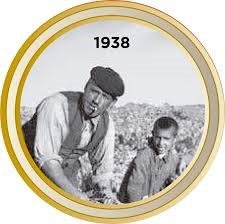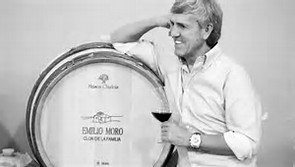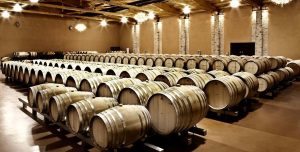
GQ Man of the Month is Spanish wine Industrialist
In June 2013, Jose Merino Moro was named GQ Man of the Week – not the usual award for a wine industry CEO who spends months of the year digging in the terroir of his family vineyard in Spain. Looking comfortable and charming at a trendy NYC restaurant, Moro assured me that he actually looked forward to spending time in the vineyards with soil creeping under his fingernails, and dusting his sneakers. As the CEO of one of the most profitable wineries in Ribera del Duero, Emilio Moro wineries produce 1.2 million bottles per year and his wines are exported to 70 countries.

1. Why did the family get into the wine business?
The Moro family has been committed to making wine and viticulture since 1932. Moro’s grandfather had a passion for wine and saved the vineyard from the massive uprooting that took place in Ribera del Duero during the war. “When everyone else decided to plant potatoes and other vegetables, the Moro family stuck to their vines,” Moro commented.
When asked about his introduction to the wine industry Moro commented, “My grandfather taught my father everything he knew about wine and he in turn taught us, the third generation. He taught us his love and passion for winemaking. I do not have memories that don’t include wine in them.”
“At first, Emilio Moro was a small and modest winery in the Ribera del Duero, producing small quantities of wine that was sold locally and enjoyed with friends and family. Today we export our wines to over 50 countries around the world and our brand is earning greater recognition by wine critics and industry professionals. This has been achieved thanks to the third generation, (me and my siblings), who decided that the world needed to know about our wines and we worked hard and with insatiable passion to promote the wines and improve them constantly.”

2. What motivates you to be in the industry?
“My motivation is my family, my tradition and everything I learned as a child, that passion that my father taught me and my siblings.”

3. Explain changes in the industry
“The industry is competitive. We are always changing to be competitive. We listen to the developments in innovation and we implement them constantly; however, we do not have competitors. We just need to focus on making the best wine possible and do our best, without taking into account what others are doing. We innovate constantly, but not because others are doing the same thing, but because we believe this is absolutely necessary to keep improving the quality of our wines. We will do whatever it takes for our wines to improve, independent of what others do.”
4. Are you using new technology at the terroir level?
“We are constantly innovating. We are big in the innovation department. With a groundbreaking app for the Ribera del Duero, we have extended the digital transformation to the vineyard. The use of this app avoids wasting time in unnecessary trips and its use allows an optimum control of the crops. This will enable us to take urgent measures in the case of extraordinary situations. It will help us control the productivity of our vineyards, access climate data, and manage work reports. It has endless possibilities.
“We have also implemented the Oresteo System, a pump over system that allows us to make the most of the CO2 generated during the fermentation. Emilio Moro winery was the first winery in the Ribera del Duero to use this system. Many renowned wineries in the area are interested in it. It helps with energy savings, allows a higher flexibility than the traditional pump over and we can make the most of the CO2 produced during fermentation, among other benefits.
“We use drones in our vineyards to determine the quality and conditions of each plot and we collaborate with different universities to produce our own yeast.”

5. Barrel Aging
“I do not have to be the one decide when to use the barrel for ageing. The barrel has to complement the wine we are making and allow the fruit to have maximum expression. We use both American oak and French oak barrels, depending on the attributes we want to give to the wine.
“For example, for our top wines, Valderramiro and Sanchmartin: the first one ages in American and French oak, whereas the latter ages in French oak solely – because the chalky soils of the Sanchmartin are better complemented by the aromas and characteristics of French oak and Valderramiro asks for a stronger, bolder oak ageing.
“I normally prefer French new barrels (our top wines are Valderramiro and Sanchomartin always use first use barrels) and we sell them after three years. We have currently started working with 500 liter barrels in order to give more importance to the fruit and less to the oak and so far, we like the result.
“Making a perfect wine needs a few elements; you need to have precise knowledge of your vineyards, your terroir, how you feel about the wine, what the market wants and how people understand wine. If you mix all those elements you will surely produce the best possible wine. This is today’s challenge – to earn more consumers.”
6. Market complexity and channels of distribution
“The distribution channel is key. You have to have good logistics. All our wines are isolated perfectly. We introduce them in controlled temperature containers and we measure the temperature constantly to maintain it between a minimum and a maximum. This is how we check that the wine reaches the distributor in optimum condition.
“Nonetheless, when the distributor sends the wine to the retailer, if the restaurant or the store doesn’t understand the importance of maintaining the wines at a good temperature and they leave the wines unattended, they can get damaged by heat.
“We know the importance of transport and logistics, we do everything we can to guarantee the wine will arrive to the consumer in perfect conditions; we rely on our disturbers and restaurants to keep that going.”
7. Airline distribution?
“It would be really easy for great hotel chains and airlines to include our wines worldwide; however, what they focus on is the price. They ask for very good prices and huge discounts and Emilio Moro doesn’t make any discounts. Our discount is the maximum quality during our winemaking process to ensure the best quality wines. Our wine has a price and it is normally not compatible with what airlines and hotels are looking for.”
8. Plans for the future
“A piece of exciting news is the new white wine we are developing. This will be a Godello wine and the area of production will be Beirzo, also in Spain. We hope to be able to release the wine to the market in the coming year.
“We are also producing another new wine in Ribera del Duero, free of sulfites and certified organic, in order to expand our wines to those people who are allergic to sulfites. The winemaking method for this new organic wine reminds me of how my father used to produce wine and it will bear the name of my mother (La Felisa) who loved his wines. She is one of the reasons we decided to make this wine.”
Future of Spanish wines in the USA

Spain is the only country in the world that is known to make red wines from tempranillo, using traditional aging techniques and creating unique treasures from some vintages. In general, the American perception of Spanish wines is very positive. They are not perceived as “cheap,” but have a reputation for quality and value. Americans enjoy red Spanish wines and over the years they have been willing to pay increasingly higher prices for them. We are fortunate to have access to the vineyards of Emilio Moro whose wines will continued to enhance our dining experiences.
© Dr. Elinor Garely. This copyright article, including photos, may not be reproduced without written permission from the author.
